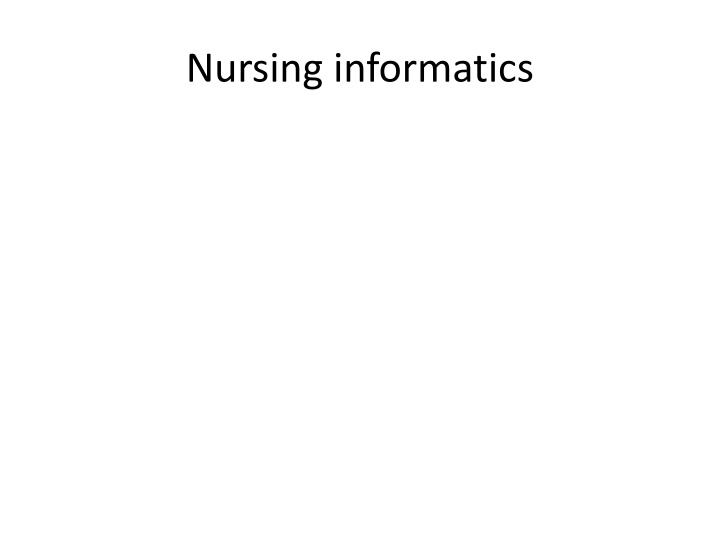
Nursing Informatics: Applications and Impact
Discover the significance of nursing informatics, from its historical roots to its practical applications in healthcare settings. Explore how technology enhances nursing care, administration, education, and research, benefiting both patients and healthcare professionals.
Download Presentation

Please find below an Image/Link to download the presentation.
The content on the website is provided AS IS for your information and personal use only. It may not be sold, licensed, or shared on other websites without obtaining consent from the author. If you encounter any issues during the download, it is possible that the publisher has removed the file from their server.
You are allowed to download the files provided on this website for personal or commercial use, subject to the condition that they are used lawfully. All files are the property of their respective owners.
The content on the website is provided AS IS for your information and personal use only. It may not be sold, licensed, or shared on other websites without obtaining consent from the author.
E N D
Presentation Transcript
1. Nursing Informatics Sanil Varghese 2. HEALTH CARE INFORMATICS- HISTORY 3. MEANING Informatics comes from the French word informatique which means computer science . Informatics is defined as computer science+information science.
4. DEFINITION Hebda (1998), defines nursing informatics as the use of computers technology to support nursing, including clinical practice, administration, education and research. ANA (American Nurses Association) 1994, has defined nursing informatics as the development and evaluation of applications, tools, processes and structures which assist nurses with the management of data in taking care of patients or supporting the practice of nursing.
5. APPLICATION OF NURSING INFORMATICS / GENERAL PURPOSE Nursing Clinical Practice: Work lists to remind staff of planned nursing interventions. Computer generated client documentation. Electronic medical record (EMR) and Computer based Patient Record (CPR). Monitoring devices that record vital signs and other measurements directly into the client record (EMR). Computer generated nursing care plans and critical pathways. Automatic billing for supplies or procedures with nursing documentation. Reminders and prompts that appear during documentation to ensure comprehensive charting
6. Nursing Administration (Health care information system) Automated staff scheduling. E-mail for improved communication. Cost analysis and finding trends for budget purposes. Quality assurance and outcomes analysis. 7. Nursing Education: Computerized record keeping. Computerized assisted instruction. Interactive video technology. Distance learning- web based courses and degree programmes. Internet resources- formal nursing courses and degree programmes. Presentation software for preparing slides and handouts- power points and MS words.
8. Nursing Research: Computerized literature searching- CINHAL, Medline and web sources. The adoption of standardized language related to nursing terms-NANDA etc. The ability to find trends in aggregate data, that is data derived from large population groups- SPSS. 9. Patient Education: Nursing informatics can be used for symptom management and patient education. The nurse can access the information for the patient or teach the patient where to find appropriate and helpful information. For example, on an oncology unit, nursing informatics can be used to teach patients effective symptom management of the treatment modalities which often cause pain, fatigue and poor nutritional status. Nursing informatics can also aid in other nursing interventions of the oncology nurse, such as analgesic administration and stress- reduction techniques.
10. Clinical Alert System: The computerized clinical alert system can be used in conjunction with the hospital pharmacy. A system design is created to alert both pharmacy and health staff when two or more drug prescriptions are incompatible. 11. Patient Data: Nursing informatics can also be useful in a physician s clinic. In a managed care environment, information systems make administrative management more efficient. The private practitioner, program or facility to manage every aspect of patient care can use one data management system. In each of these health care settings data management systems can be applied to treatments, diagnostics, documentation, practice management, insurance claims and referrals and protocols as well as treatment and diagnostics results
12. Telehealth: Telehealth includes the use of telephones and sophisticated image transmission systems like ECG, faxes and remote camera imaging. Telehealth places the ambulance personnel in touch with the Emergency Department and it also operates to put the generalist nurses and doctors at the ED in touch with specialists. Telehealth is used to evaluate the stroke victims while they are in transit so appropriate therapy can be initiated quickly upon arrival at the ED. In similar fashion, a nurse practitioner in a remote ED might be guided via telephone in the proper procedure for inserting chest tubes so a man with a collapsed lung could be stabilized for subsequent transport to a major hospital. Finally, nursing informatics can be useful for interdepartmental communication such as ordering supplies from central supply, lab work, etc.
13. Clinical Information: In order for the nurse to ensure the patient is receiving the most up-to-date care for a variety of chronic conditions, the National Institute of Health (NIH) have an agency designed to offer such guidance. Clinical practice guidelines can be found at The practice guidelines found at this site provide management information for asthma, cholesterol, hypertension and obesity. Clinical practice guidelines for the management of diabetes. Further information can be found through the Medscape Nurses site and National Institute of Health-
14. SIGNIFICANCE OF NURSING INFORMATICS I. Nursing informatics facilitates communication. II. Nursing informatics allows articulation of organized information. III. Nursing informatics leads to credibility. 15. BENEFITS OF COMPUTER AUTOMATION IN HEALTH CARE 16. EMR Improved access to the medical ward: the EMR can be accessed from several different locations simultaneously, as well as by different levels of providers. Decreased redundancy of data entry: for example, allergies and vital signs need only be entered once. Decreased time spent in documentation: automation allows direct entry from monitoring equipment, as well as point of care data entry
